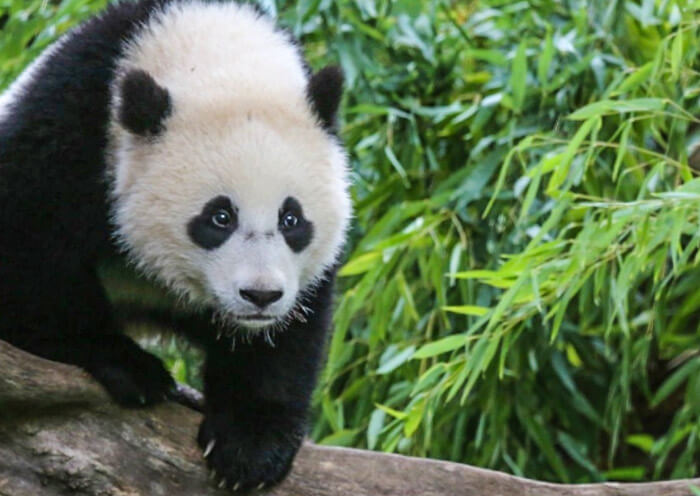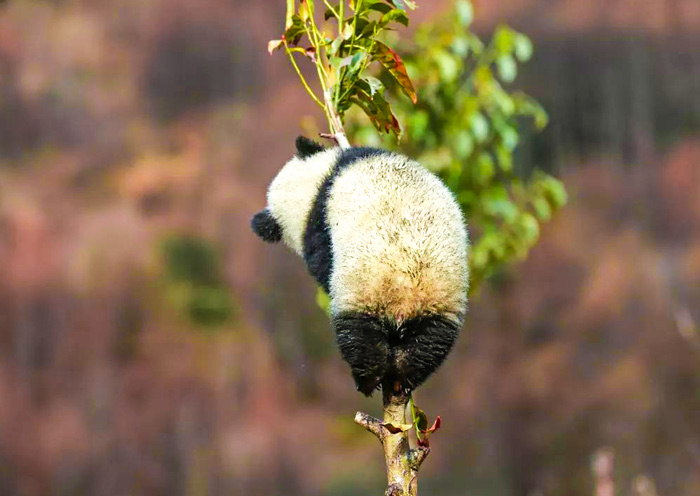Why China Panda Tours?

"Excellent Tour, best experience"
"A unique experience despite a difficult context thanks
to an experience team of organisers"
Welcome to China, the hometown of the giant panda. We have carefully selected four of the best panda tour packages for you. These panda tours not only allow you to observe China's iconic giant pandas but also provide an opportunity to experience the leisure time of Chengdu's people, join a Panda Keeper's daily work, practice Qingcheng Kung Fu like the Kung Fu Panda Po, admire the largest and tallest stone-carved statue of buddha - Leshan Giant Buddha (a World Cultural Heritage Site), capture the stunning landscapes of Jiuzhaigou and Huanglong Valley (World Natural Heritage Sites), and more. Each of these panda tour packages provides a unique exploration of the panda's hometown, its culture, and its beloved national treasure - the giant panda. Whether you're a panda fan, a nature lover, or a cultural explorer, these panda tours promise unforgettable memories and remarkable panda journeys. Contact us for your panda tour, designed to offer classic, immersive, and highly recommended experiences.
The giant panda is an iconic symbol of China and one of the most adorable creatures in the world. Southwest China's Sichuan province is the homeland of giant pandas, with 1,387 pandas accounting for 74.4% of the total number of wild pandas in the country. Chengdu City, the capital of Sichuan, is known as the Panda City, and it is the only large metropolis in the world where both captive and wild pandas can be found. Also, the Chengdu section of the Giant Panda National Park is home to 73 wild giant pandas. Therefore, when mentioning panda tours, it is highly recommended to take a Chengdu Panda Tour, Dujiangyan Panda Tour, or Wolong Panda Tour. Here are the Top 9 Panda Tours for you to visit Chengdu, Dujiangyan, and Wolong in Sichuan. Join us to make your dream of a panda tour come true.
2025 >>
Chengdu, the capital of Sichuan province, has two international airports and usually served as a popular gateway to China after Beijing and Shanghai. Take our Chengdu Panda Tours to enjoy a leisure time like a panda or a Chengduer.
2025 >>
Dujiangyan, 2 hours's drive from Chengdu, is well-known for its World Heritage Sites of Mount Qingcheng - Dujiangyan Irrigation System. Take our Dujiangyan Panda Volunteer Tours to experience panda volunteering and a Qingcheng Kung Fu lesson.
2025>>
Wolong, located in the Wolong Nature Reserve and belonging to the Giant Panda National Park, is a 3-hour drive from Chengdu. Take our Wolong Panda Volunteer Tours to experience being a panda keeper while also going on a hike in the panda habitat.
The panda is China's national treasure. Welcome to the panda hometown to discover more about these cute animals and the real China. Here are four of the most popular China Panda Tours for you to visit top destinations such as Beijing, Shanghai, Xian, Tibet, Chengdu, Guilin, Yangshuo, and Zhangjiajie. Besides pandas, China is a vast country with diverse landscapes, splendid cultures, stunning scenery, a time-honored history, and adorable and precious animals. Contact us now to plan your China Panda Tour.

.

1.1st Panda Base - Chengdu Panda Base, Chengdu Panda Tour

2.Be a Panda Keeper - Dujiangyan Panda Base, Panda Volunteer Tour

3.Visit Panda Habitat - Wolong Panda Base, Panda Volunteer

4.Giant Panda National Park, the Wild Panda Habitat
1. What are the Top 10 Fun Facts about Pandas?+
1). Pandas are good at climbing trees.
2). Pandas are good swimmers.
3). Pandas are bears that do not hibernate.
4). Pandas are carnivores but mainly eat bamboo (99% of their diet).
5). Pandas occasionally eat eggs, fish, and even small mammals.
6). Pandas spend 10-16 hours a day eating bamboo.
7). Pandas poo 40 times daily (100 droppings per day; about 20kg poo).
8). Adult pandas can weigh up to 125 kg, while newborn pandas weigh around 200g.
9). Pandas have a sixth finger, called a "Pseudo-thumbs" (helpful like a hand).
10). The name "panda" originally referred to the red panda until the discovery of the giant panda.
2. Why do people like pandas? Why do the Chinese love pandas?+
Pandas are adored for their cuteness. They have a unique appearance that is round and fluffy, making them stand out from other animals. But why do we love pandas? Perhaps it is because of the way they eat, which resembles the way humans sit on the floor. Or maybe it's because of their distinctive eyes, with eye patches that make their eyes look bigger, which people find attractive because it reminds them of children.
For the Chinese, giant pandas have long been a symbol of peace and friendship, which aligns perfectly with Chinese values and worldviews. Additionally, the black and white color of the panda is consistent with the cultural beliefs of China, specifically the connection to the Taiji Yin and Yang.
Pandas are very interesting to watch due to their unique black and white coat, bamboo diet, and "funny" behavior like rolling down hills, sleeping for over 10 hours a day, and "panda kung fu" wrestling. Their playful cub personas also attract much attention.
3. Why are pandas endangered? What is the biggest threat to pandas?+
Giant pandas are one of the most beloved animals in the world. They are bears native to central China and are easily recognizable by their large, distinctive black patches around their eyes, over their ears, and across their rotund body. Giant pandas are endangered primarily due to habitat loss, poaching, and low reproductive rates.
Habitat loss due to human activities is the main reason why giant pandas are endangered. Deforestation, urbanization, and infrastructure development have greatly reduced their natural habitat in China. As their mountain forest habitats were cleared for farming and development, panda populations became isolated and vulnerable. They have a very specialized bamboo diet, so the loss of habitat also meant the loss of their food source.
Pandas are difficult to mate because female pandas only ovulate once a year. Not only that but the window that a male panda has to inseminate the female while she has an egg ready to go is only about 36 to 40 hours.
The adult giant panda has very few natural enemies. One of the known enemies of the giant panda is the snow leopard, which may seize a baby panda that has wandered away from its mother, or a pack of wild dogs may also capture a wandering cub. However, humans are the greatest threat to pandas in China due to habitat destruction and poaching.
4. Where can I see giant pandas? How many giant pandas are left in the wild?+
Most giant pandas live in a few mountain ranges in central China. The best way to see pandas is at conservation and breeding centers in China, such as the Chengdu panda Base, Dujiangyan Panda Valley, Dujiangyan Panda Base, Wolong Panda Base, Bifengxia Panda Base, and Shaanxi Foping Panda Base. You can view various pandas, including newborn cubs, in indoor-outdoor enclosures and nurseries.
Zoos around the world also have some pandas, but their populations are limited. Countries like the US, Canada, Belgium, France, Thailand, and others have pandas in zoos. For example, giant pandas can be seen at zoos in the US, such as the San Diego Zoo, Zoo Atlanta, and the Smithsonian's National Zoo in Washington, DC.
It is possible to see giant pandas in the wild, particularly in Giant Panda National Park, although it can be challenging as they are rare and elusive animals. There are approximately 1,864 giant pandas left in the wild, mostly in the mountainous regions of Sichuan, Shaanxi, and Gansu in China. However, their numbers are slowly increasing from around 1,000 wild pandas in the 1980s due to conservation efforts.
Furthermore, research shows that 85% of wild giant pandas reside in Sichuan province, China. The Chengdu section of the Giant Panda National Park, which is the habitat of giant pandas in the wild, is home to 73 wild giant pandas, according to the fourth national giant panda survey.
5. What do giant pandas eat? How many hours a day do pandas eat?+
As you may know, pandas love to eat bamboo. However, pandas only eat about 42 bamboo species, including arrow bamboo and wood bamboo. Each species has a life cycle and will flower and die off every 20 to 40 years, depending on the species. Pandas need to have other species available to eat or be able to migrate to a different area when the bamboo dies off.
As 99% of a panda's diet is bamboo, they prefer bamboo shoots, stems, and leaves, especially shoots. Pandas are picky and clever, as they eat different types and parts of bamboo according to the season. In spring and summer, when bamboo shoots are plentiful, pandas like eating different kinds of shoots; in autumn, pandas eat more bamboo leaves; in winter, pandas prefer bamboo stems, which include more nutrients.
Although bamboo is the giant panda's favorite food, they also eat fruit (such as apples) and vegetables (such as carrots, pumpkins, and fungus). Pandas can eat small animals on occasion, such as fish, bamboo rats, or musk deer fawns.Pandas are carnivores, however, they are primarily recognized as vegetarian now.
Besides, pandas drink fresh water from rivers and streams once or twice a day. Because bamboo shoots are more than 60 percent water, pandas can get water while eating bamboo shoots.
By the way, baby pandas drink their mother's milk until they are six months old and then start eating bamboo. Pandas have very little breast milk, so captive panda cubs are fed milk made from a mixture of milk, powdered milk, and various vitamins.
With very little nutritional value in bamboo, pandas must eat 23–40 kg of bamboo every day (26 to 38% of their body weight) to meet their energy needs. To obtain this much food, a panda must spend 10 to 16 hours a day foraging and eating. The rest of their time is spent mostly sleeping and resting.
6. Why do pandas look so lazy? Do pandas get tired easily?+
Pands often appear lazy due to their slow movements and tendency to sleep for long periods of time. However, this is actually a natural behavior for pandas. Pandas are herbivores in the body of carnivores, and with a diet of 99% bamboo, they have developed adaptations for dealing with their low-calorie food, including taking it easy.
That is why pandas look so lazy – it allows them to save energy, and the lazy lifestyle allows pandas to survive on their low-quality diet. The daily energy expenditure values for giant pandas are substantially lower than those for koalas, for example, and more akin to those of three-toed sloths. Pandas have a low metabolic rate, which means that they require less energy than other animals of their size. Besides, pandas conserve their energy by moving slowly and sleeping for up to 14 hours a day.
While pandas may look lazy, they are actually strong and agile animals. They are excellent climbers and can run at speeds of up to 20 miles per hour when necessary. Pandas also have a high endurance level and can swim for long distances.
Pandas don't necessarily get tired easily, but they have evolved to conserve their energy by moving slowly and sleeping for long periods of time. This behavior is a natural adaptation to their unique diet and lifestyle.
7. Can I hold a panda cub or feed a panda? Can I volunteer with pandas?+
In general, pandas are not aggressive animals. However, mother pandas can become defensive when protecting their cubs, especially during the first few months after birth. Male pandas also spar with each other during mating season. Although pandas are often assumed to be docile, they have been known to attack humans, presumably out of irritation rather than aggression.
Direct contact with pandas is not allowed since 2018. Holding panda cubs would interfere with their care, bonding with handlers, and increase the risk of disease transmission. Additionally, feeding and interacting with pandas is left to panda keepers for the safety of both the pandas and visitors.
However, it is possible to participate in a panda volunteer tour at certain conservation centers in China. Opportunities are limited, and you can contact a tour operator to book the service ahead of time.
8. Are giant pandas a type of bear? How long do giant pandas live?+
Yes, giant pandas are a type of bear unique in China and are classified as a member of the family Ursidae.
The average lifespan of a giant panda in the wild is about 15-20 years. However, with proper care in captivity, they can live into their 30s. The oldest panda in captivity was Jia Jia, who lived to 38 years old.
9. When is the best time to visit pandas in China?+
The best time of year to visit pandas in China is during the spring and fall, when the weather is mild and the bamboo is in bloom. Spring (March-May) has pleasant temperatures, and pandas are more active during this time. In the fall, you can see baby pandas that were born in the summer.
Moreover, the best time to see the Giant Pandas is during their meal times or play times. Pandas love cool weather, so early morning before 9 o'clock is a suitable time to watch them when they are more active. For instance, you can observe their playtime from 10:30 am to 11:00 am and their lunchtime from 11:00 am to 12:00 pm.
10. How long is a typical panda tour? How much does a panda tour cost?+
A panda tour can range from a half-day excursion to a multi-day trip, depending on the itinerary and activities included.
The cost of a panda tour varies depending on the length of the tour, the activities included, and the level of luxury. Prices can range from a few hundred to several thousand dollars.
Typically, panda tours include visits to conservation centers (panda bases) to see and learn about the pandas. Other activities may include a panda volunteer program, a panda habitat hike, sightseeing at world heritage sites, museum visits, kid-friendly cultural activities such as Kung Fu lessons and traditional tea ceremonies, Sichuan Opera performances, Chinese meals, and tour guides.
Panda tour prices vary but average around $100-$300 per person for a full-day visit, depending on the itinerary, accommodation, and time of year.

Maziar
Australia
Destination(s): Beijing, Xian, Shanghai, Tibet, Chengdu/Sichuan
Date of Experience: Jul 07, 2023
Tour Customized by: Isaac
You May be Interested in This Tour: 15 Days China Group Tour: Classic China, Panda & Holy Tibet Tour

Tom
USA
Destination(s): Beijing, Xian, Shanghai, Chengdu/Sichuan
Date of Experience: May 16, 2023
Tour Customized by: Emma
You May be Interested in This Tour: 10 Days China Family Classic Tour with Panda Kingdom

Jackson
Germany
Destination(s): Beijing, Xian, Chengdu/Sichuan, YangtzeRiver, Chongqing
Date of Experience: Sep 05, 2019
Tour Customized by: Amy
You May be Interested in This Tour: 15 Days Diverse China Tour with Pandas, Yangtze & Zhangjiajie Mountains
Create a tour based truly on your preferences, including all aspects of your travel in the destination